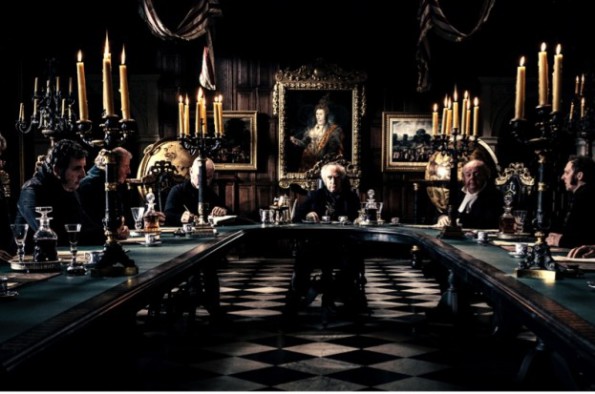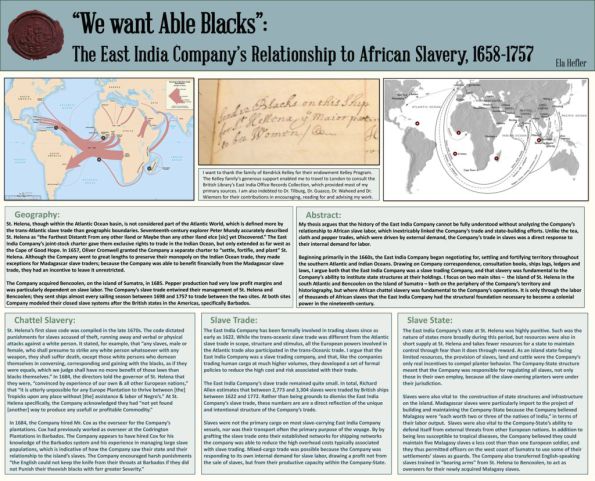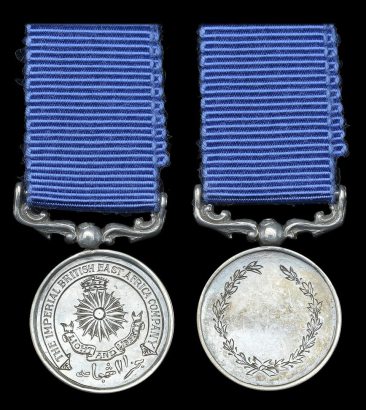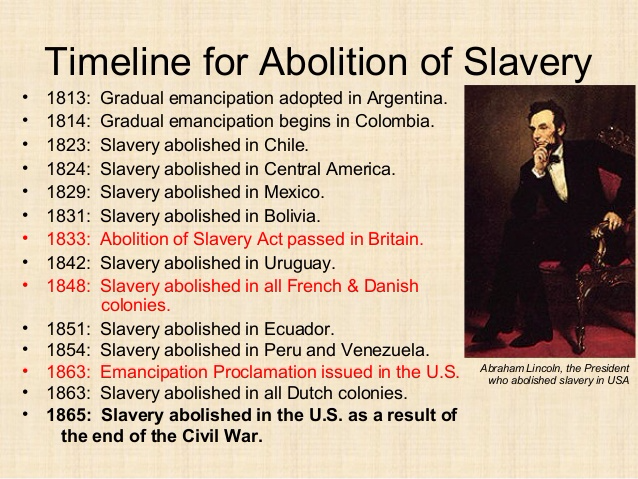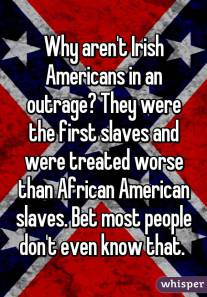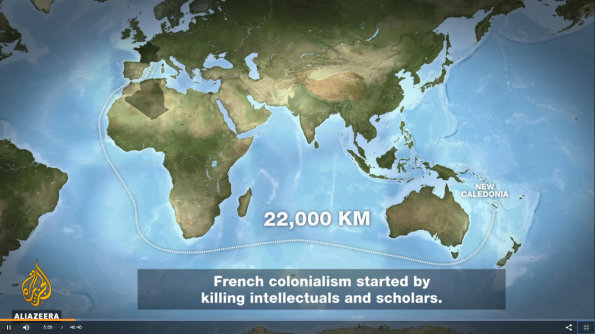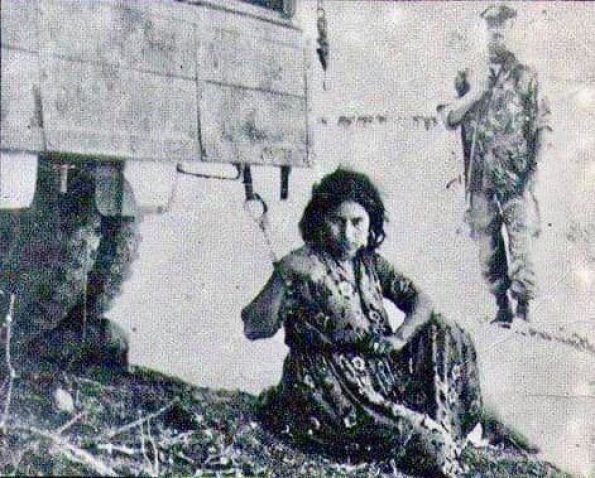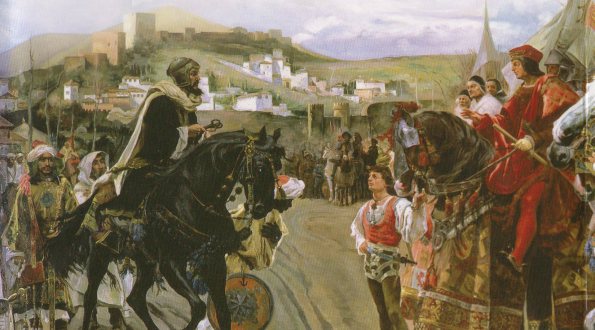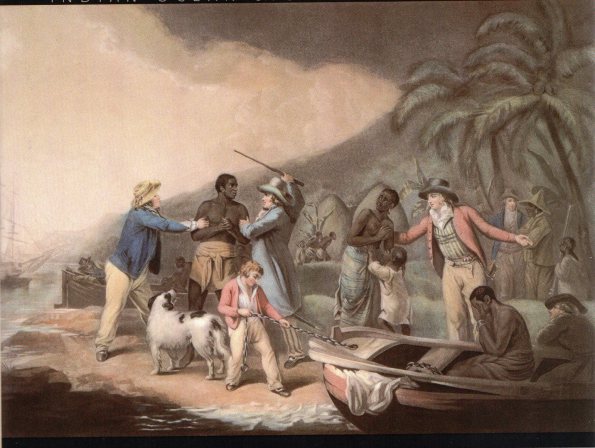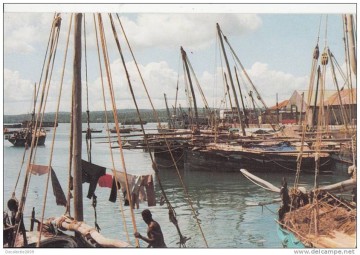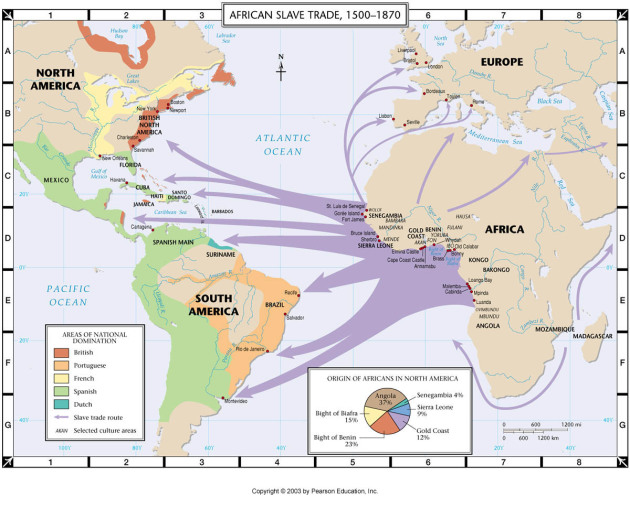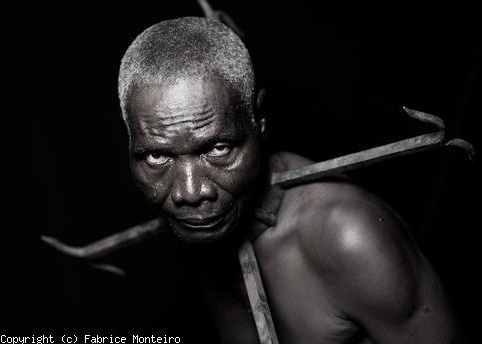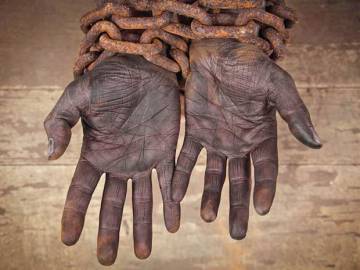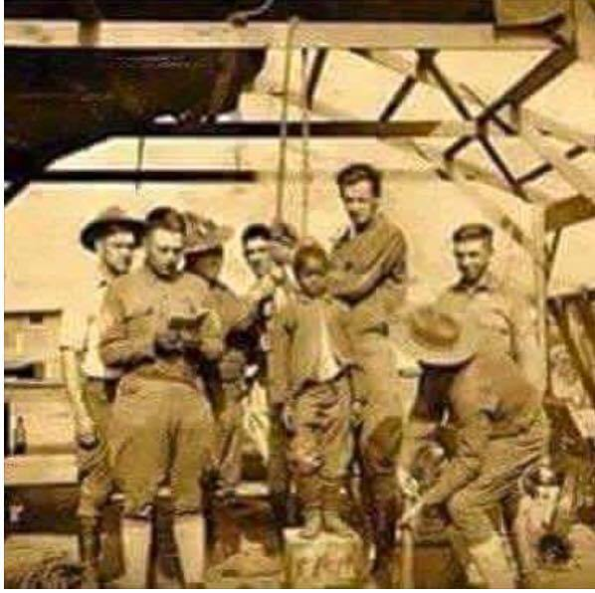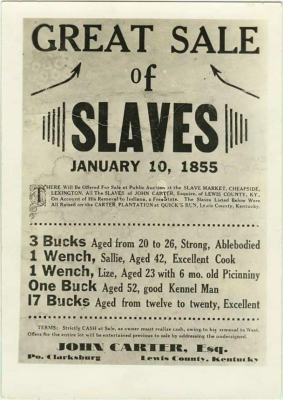The East India Company: How a trading corporation became an imperial ruler
Featured in BBC One’s new period drama Taboo as a company with huge influence and power – and one which is unafraid to further its interests by nefarious means – the East India Company was founded during the rule of Queen Elizabeth I and grew into a dominating global player with its own ‘army’.
Writing for History Extra, Dr Andrea Major gives an insight into one of history’s most powerful companies, and its rise to political power on the Indian subcontinent…
“We want Able Blacks”:
The British East India Company’s African Slave Trade
https://alendalux.davidson.edu/humanities/ela-hefler/
Do you see a pattern here…Imperialists
In 1600, a group of London merchants led by Sir Thomas Smythe petitioned Queen Elizabeth I to grant them a royal charter to trade with the countries of the eastern hemisphere. And so, the ‘Honourable
Company of Merchants of London Trading with the East Indies’ – or East India Company, as it came to be known – was founded. Country’s assets, natural resources plundered, in trillions over time, yet
not many know, they were Slave Traders too.
The British South Africa Company's administration of what became Rhodesia was chartered in 1889 by Queen Victoria of the United Kingdom. Rhodes a mass murderer that devastated the local people of
Central Africa through dispersing in forcefully taking over of its assets and natural resources.
The Colonial British Government always had an upper hand during the “Imperialist” era of the nineteenth century Great Britain authorized the creation of four chartered companies and endowed them with
extensive political as well as commercial privileges, Sir William Mackinnon’s company “The Imperial British East Africa Company”, chartered in 1888 was one of them (Wiki).
In 1893 Sir William Mackinnon died, the IBEAC transferred its administration rights of the territory to the British Government.
In this particular case there was brewing conflict between rival factions ultimately prevented the company from investing the necessary time and money into this venture. The four groups involved in
Uganda, the Kabaka, French Catholics, Protestants, and the Company.
The British East Africa Company proved to be an ineffective attempt at allowing commercial businesses local administrative rights. Inevitably, in 1894, the British government declared a protectorate
over Uganda effectively dissolving IBEAC and assuming full responsibility (Wiki).
His statue that was in Mombasa now stands proud at his birth place in Scotland called Campbeltown.
40 Violent Realities in the Making of the British Empire
https://historycollection.co/40-violent-realities-in-the-making-of-the-british-empire/7/
In 1888 the Imperial British East Africa Company (IBEAC) which was based in Bombay was given a charter by Queen Victoria just as “The British South Africa Company's” administration was given in
1889 for Rhodesia (from South Africa to Northern Rhodesia bordering Tanganyika up north).
Following the defeat of the Boers in the Anglo-Boer or South African War (1899–1902), the Union of South Africa was created as a self-governing dominion of the British Empire on
31 May 1910 in terms of the South Africa Act 1909 and the taking over by the Colonial inevitably happens after the preliminary set up of invasion and the Carte Blanche is openly exercised
through-out the might of imperialism.. PERIOD!
So, we can clearly see the mighty empire building up from down south right up to north right up to Egypt.
Coming back to IBEAC medals or any other that are questionable from an honorary point of view in terms of principle, morale, ethics, etiquettes etc, are these not a way of showing or gauging
the deplorable acts that were carried out by such as The British honours system that demeans by the very means of rewarding individuals' personal bravery, achievement, or service to
the United Kingdom and the British Overseas Territories. Their system consisted of three types of award – honours, decorations and medals in its appropriate capacity…
Some folks still dwell on misery of others because they are living on the very blood money that they would like to think were just but surely and obviously deceitful, immoral, corrupt, unprincipled,
dishonest, devious, deceitful….etc
Slavery Timeline 1400-1500
A Chronology of Slavery, Abolition, and Emancipation in the Fifteenth Century
http://www.brycchancarey.com/slavery/chrono2.htm
The European Slave Trade, the destruction of Africa by Portugal
http://www.lisapoyakama.org/en/the-european-slave-trade-the-destruction-of-africa-by-portugal/
Slavery Abolition Act 1833. An Act for the Abolition of Slavery throughout the British Colonies; for promoting the Industry of the manumitted Slaves; and for compensating the Persons hitherto entitled to the Services of such Slaves.
In the British Empire, the labourers, originally referred to as "coolies", were indentured labourers who lived under conditions often resembling slavery. The system, inaugurated in 1834 in Mauritius, involved the use of licensed agents after slavery had been abolished in the British Empire. The agents imported indentured labour to replace the slaves.
In the 1860s, David Livingstone's reports of atrocities in Africa stirred up the interest of the British. In 1890 Britain handed control of the strategically important island of Heligoland in the North Sea to Germany in return for control of Zanzibar, in part to help enforce the ban on slave trading.
How extraordinary it was to discover, then, that one of this small state’s kings was also one of history’s greatest mass murderers. Leopold II (1835-1909).
Under the reign of terror instituted by King Leopold II of Belgium (who ran the Congo Free State as his personal fief from 1885 to 1909), the population of the
Congo was reduced by half -- as many as 8 million Africans (perhaps even 10 million, in Hochschild's opinion) lost their lives.
How and why were these heinous crimes allowed to continue to happen under the charade of “abolition of slave trade” yet King Leopold II of Belgium happily carried on with these brutal sickening acts
right under their very noses without any sort of repercussions from the Colonials?
In fact all these barbaric acts were swept under the carpet and never reported, hoping it will never raise its ugly head ever again.
UN tells Belgium to apologise for its colonial past in Congo
The United Nations has told Belgium to apologise for its colonial past and criticised its newly renovated Africa Museum for not doing enough to exorcise the demons of it exploitation of the
Congo.
Filled with more than 180,000 looted items and 500 stuffed animals, the museum celebrated the Belgians, who turned the Congo into a slave state ruled by Leopold II, for more than a century. The king’s brutal regime, which inspired Joseph Conrad’s Heart of Darkness, killed millions and ruthlessly plundered the region of rubber.
How the Myth of the "Irish slaves" Became a Favourite Meme of Racists Online… Irish scholar Liam Hogan has been tracking and debunking this reincarnated meme since he first saw it in 2013. Last year, Hogan published an impressive five-part series exposing the myth and provided a detailed historical analysis of the origins and evolution of the meme.
I’m a research librarian at the Limerick City Library and an independent scholar. I am particularly interested in the complex historical relationship between Ireland and the Transatlantic Slave Trade.
Muslim Holocaust Muslim Genocide
This site is provided as a humanitarian public service to inform people about past, present and predicted future Muslim Holocausts and Muslim Genocides.
This site is necessary because of extraordinary lying by omission and commission by Western media, journalists, writers, academics and politicians in relation to such atrocities against Muslims and against non-European Humanity in general.
https://sites.google.com/site/muslimholocaustmuslimgenocide/
Exile In New Caledonia
The untold story of Algerians deported by France to the Pacific island in the 1870s and their descendants today.
Fighter Zuleikha Al-Shayeb, by Yasin Dwyer
The picture below was taken in Algeria, Oct. 15, 1957 of the Algerian freedom fighter Zuleikha Al-Shayeb, tied to a military vehicle after the French Occupation Forces captured her. Here she is photographed just before she was dragged through the streets of Algiers chained to the vehicle, while French occupation soldiers warned citizens through loudspeakers, that this would be the 'reward' for anyone who rebels against French occupation and that France would have no mercy on anyone, not even females. She did not scream or speak throughout. She was subsequently tortured for ten days non-stop, before they threw her to her death from a French military helicopter. Her body was never found until in 1984, when an Algerian peasant remembered he had buried a body he found lying on the side of the road and took authorities to the location; where indeed they found the bones of a woman and bits of cloth from a dress.
After the martyrdom of Zuleikha Al-Shayeb, along with over one million Algerians, the French were forced to acknowledge that they were no match for the honour and dignity of the Algerian people. On July 5th, 1962, Algeria achieved independence from France. May The One continue to bless the people of Algeria and may He grant the highest of paradise to Zuleikha Al-Shayeb and all the martyrs of the Algerian revolution.
The Purging of Spain, history of terrorism
Seldom does a centuries-old story have such remarkable contemporary resonance. In April 1609. King Philip III of Spain signed an edict denouncing the Muslim inhabitants of Spain as heretics, traitors, and apostates. Later that year, on threat of death, the entire Muslim population of Spain was given three days to leave Spanish territory.
In the brutal and traumatic exodus that followed, entire families and communities were obliged to abandon homes and villages where they had lived for generations, leaving their property in the hands of their Christian neighbours. In Aragon and Catalonia, Muslims were escorted by government commissioners who forced them to pay whenever they drank water from a river or took refuge in the shade. For five years the expulsion continued to grind on, until an estimated 300,000 Muslims had been removed from Spanish territory, nearly 5 percent of the total population. By 1614 Spain had successfully implemented what was then the largest act of ethnic cleansing in European history, and Muslim Spain had effectively ceased to exist.
Blood and Faith is celebrated journalist Matthew Carrs riveting chronicle of this virtually unknown episode, set against the vivid historical backdrop of the history of Muslim Spain. Here is a remarkable window onto a little-known period in modern Europen a rich and complex tale of competing faiths and beliefs, of cultural oppression, and resistance against overwhelming odds.
The terrorism of European slave raiders and the destruction of Africa
"Most studies and textbooks on the slave trade focused on the 18th and 19th centuries, a time when the slave trade had become the main activity in Black Africa (...) This historical approach has always avoided an analysis of the military and other means deployed by European slave traders in the 16th and 17th centuries to defeat African kings and elites who resisted, and to put docile and corrupt leaders in their place…..written by Government of Zimbabwe.. West Chester University..
Read about the ….Heavily Abridged ‘Slave Bible’ Removed Passages That Might Encourage Uprisings… The rare artefact is the focus of a new exhibition at the Museum
of the Bible in Washington, D.C…
When 19th-century British missionaries arrived in the Caribbean to convert enslaved Africans, they came armed with a heavily edited version of the Bible. Any
passage that might incite rebellion was removed; gone, for instance, were references to the exodus of enslaved Israelites from Egypt. Today, just three copies of the so-called “Slave Bible” are known
to exist.
During the Age of Exploration, the Portuguese Empire was the first European power to gain control of Zanzibar, and kept it for nearly 200
years.
Between 1500 and 1850, European traders such as The East India Company shipped hundreds of thousands of African, Indian, Malagasy, and Southeast Asian slaves
to ports throughout the Indian Ocean world. The activities of the British, Dutch, French, and Portuguese traders who operated in the Indian Ocean demonstrate that European slave trading was not
confined largely to the Atlantic but must now be viewed as a truly global phenomenon.
European slave trading and abolitionism in the Indian Ocean also led to the development of an increasingly integrated movement of slave, convict, and
indentured labour during the late eighteenth and early nineteenth centuries, the consequences of which resonated well into the twentieth century.
Richard B. Allen’s magisterial work dramatically expands our understanding of the movement of free and forced labour around the world. Drawing upon extensive
archival research and a thorough command of published scholarship, Allen challenges the modern tendency to view the Indian and Atlantic oceans as self-contained units of historical analysis and the
attendant failure to understand the ways in which the Indian Ocean and Atlantic worlds have interacted with one another. In so doing, he offers tantalizing new insights into the origins and dynamics
of global labor migration in the modern world.
Slavery (The Dutch India Company's "Slave Lodge at the Cape by Helene Vollgraaf for SA Cultural History Museum).
The Portuguese took Muscat on 1 April 1515, and held it until 26 January 1650, although the Ottomans controlled Muscat from 1550 to 1551 and from 1581 to
1588.
As far back as 1822 Seyyid Said had signed a Convention with the British Government for “the perpetual abolition of the slave trade between the dominions of
His Highness and all Christian countries.”
Leopold amassed a huge personal fortune by exploiting the natural resources of the Congo, Estimates of the death toll ranged to fifteen million, innocent men, women and children. Leopold
II (9 April 1835 – 17 December 1909), Colonization 1876–1885, Congo Free State 1885–1908, Belgian Congo 1908–1960
Further, in 1832 the great Arab ruler, Sa’id bin Sultan bin Ahmed, better known as Seyyid Said, a grandson of Ahmed bin Sa’id , the founder of the the Al-Busa’id dynasty
decided to make Zanzibar the capital of his dominions in the place of Muscat.
In 1856 Seyyid Said died at sea on board his frigate The Victoria laying off the Seychelles. His two sons were to divide his possession, this caused dispute
amongst the two and Her Majesty’s government intervened and persuaded the two brothers to their dispute to the arbitration of Lord Canning, Governor –General and first Viceroy of
India.
By this award Zanzibar and the Arab possessions on the mainland became independent of Oman, recognised by France and Great Britain on March 10th
1862. 1870 Sultan Majid died and was succeeded by his younger brother , Seyyid Bargash-bin-Said.
Argument about the slave trade Tippu Tip was not from Oman but he was one of the well- known Slave trader, ivory merchant, explorer, governor led huge
expeditions into the African interior, where local chiefs sold him their villagers for next to nothing. It seems like it was not just the Omani who were involved with the slave trade, is that not a
fact?
These events did NOT mark the beginning of the slave trade to the Cape as they were already centuries old since between 1500 and 1850 by EIC (East India Company), a trade
which was also well controlled by the DEIC (Dutch East India Company) who too sponsored slaving expeditions.
These expeditions were the main source of slaves at the Cape as no burghers - private citizens - were allowed to import slaves. A second source was the DEIC’s
return fleets from Batavia which usually brought a few slaves to the Cape - sometimes for the Company’s use, but mostly to be sold to the burghers.
Foreign ships on their way to the Americas from Madagascar also sometimes sold slaves in Cape Town. Between 1658 and 1808 - when oceanic slave trade was
abolished - 63 000 slaves were imported, most of whom came from East Africa (26,5%), India (25,9%), Madagascar (25,1%) and Indonesia (22,7%).
Many books as well as website tell us the story of slavery at the Cape. The focus, unlike the Transatlantic slave trade that exported enslaved people from Africa, India, Madagascar, Indonesia, the Indian Ocean region and beyond, is on the enslaved society that existed within Africa, specifically within the Cape, South Africa.
----------------------------------------------------------------------------------
The terrorism of European slave raiders and the destruction of Africa
"Most studies and textbooks on the slave trade focused on the 18th and 19th centuries, a time when the slave trade had become the main activity in Black
Africa (...) This historical approach has always avoided an analysis of the military and other means deployed by European slave traders in the 16th and 17th centuries to defeat African kings and
elites who resisted, and to put docile and corrupt leaders in their place.
Thus, this image of Africa selling its own children has always been based on a lack of knowledge of the particularly brutal means put in place by Europeans to demolish empires that were prosperous, to exterminate any resistance to invaders ' Rosa Amelia Plumelle-Uribe “Traite des Noirs; Traite des Blancs”, pages 138-139.
https://en.lisapoyakama.org/the-terrorism-of-european-slave-raiders-and-the-destruction-of-africa/
---------------------------------------------------------------------------------------------------
The African Slave Trade: The Europeans
A new outlet for African slaves appeared in the 15th century. Portuguese explorers began voyages south along the Atlantic coast of Africa. The Portuguese were looking for a route to Asia,
but as they moved south they began setting up trading posts. First the Portuguese established trading posts along the coast of West Africa, but gradually moved further south along the coast.
Other European maritime powers followed suit. This was the beginning of the African slave trade. The Europeans differed from the Arabs in that they did not normally conduct raids themselves, but
usually bought slaves from Arab slave brokers and African chiefs. Europeans built trading post and forts all along the coast of West Africa. From Senegal south to Cameroons there were about 60 forts
that served as trading posts for the slave trade. The Europeans exchanged rum, cloth, guns, and other trade goods for their human cargo.
The slaves were transported across the Atlantic Ocean primarily to Brazil, the West Indies and the English colonies in North America. Immense fortunes were made in the trade. As the demand for slaves
expanded, whole areas of Africa were depopulated. Scholars estimate that 10-15 million Africans were transported to the New World. The European African slave trade began during the mercantilist
era.
t continued well into the industrial era. In fact because African slaves played a major role in the industrial revolution in Europe. The immense profits from West Indian sugar islands helped to
finance the industrial revolution. And the raw material for the first real modern industry, cotton textiles, was produced by slaves. The slave trade was finally ended by the Royl Navy in the mid-19th
century.
European Slave Trading in the Indian Ocean, 1500-1850 (Indian Ocean Studies) (Indian Ocean Studies Series) Paperback – 1 Jan. 2015
by Richard B. Allen (Author)
Between 1500 and 1850, European traders shipped hundreds of thousands of African, Indian, Malagasy, and Southeast Asian slaves to ports throughout the Indian Ocean world. The activities of
the British, Dutch, French, and Portuguese traders who operated in the Indian Ocean demonstrate that European slave trading was not confined largely to the Atlantic but must now be viewed as a truly
global phenomenon. European slave trading and abolitionism in the Indian Ocean also led to the development of an increasingly integrated movement of slave, convict, and indentured labor during the
late eighteenth and early nineteenth centuries and into the 20th century, the consequences of which resonated well into the twentieth century.
Richard B. Allen’s magisterial work dramatically expands our understanding of the movement of free and forced labor around the world. Drawing upon extensive archival research and a thorough command
of published scholarship, Allen challenges the modern tendency to view the Indian and Atlantic oceans as self-contained units of historical analysis and the attendant failure to understand the ways
in which the Indian Ocean and Atlantic worlds have interacted with one another. In so doing, he offers tantalizing new insights into the origins and dynamics of global labor migration in the modern
world.
https://www.ohioswallow.com/book/European+Slave+Trading+in+the+Indian+Ocean%2C+1500%E2%80%931850
Britain's Forgotten Slave Owners - 1 - Profit and Loss [couchtrippe
Austrian East India Company
What if Austria had colonised Mozambique?
Austrian East India Company
Colonisation of Delagoa Bay
In the next few years Bolts established factories on the Malabar Coast, on the South East African coast at Delagoa Bay, and at the Nicobar Islands.
The Imperial flag did not fly for long over Delagoa Bay, as alarmed Portuguese authorities who claimed the place as their own sent a 40-gun frigate and 500 men from Goa to remove Bolts’s men in April 1781, and to found the presidio of Lourenço Marques (Maputo) that established a permanent Portuguese presence there.
https://sithabileinfryslan.wordpress.com/austrian-east-india-company/?fbclid=IwAR2tSN2_cVTKjPiFNYqghOblXxNjCYpt-2Y1iV-N-sRaUHn13OSiFtGkXd4
Coolies: How Britain Re-Invented Slavery
Sheen Gurrib's five
generations, that is mesmerising and a moving tale in terms of how and where this journey is picked up from, to where it currently is, meet her father who had one thing
etched in his mind in what he wanted for his loving children and went out to make sure of it, in terms of educating his children with all his inner strength, no matter of the costs involved…fruits of
his fulfilments and his devotion in faith instilled, that has now led him to tell us his story…. Beautiful people tell it all with a smile and attached with it the fragrance of love without any sort
of bitterness…
Sheen, takes you on a journey with her to meet her ancestors and make you understand a bit more of her roots and ethnicity!
And Sheen has her dad as a special guest :)
From Indian slaves to Oxbridge PhD - The journey of my ancestors
Heavily Abridged ‘Slave Bible’ Removed Passages That Might Encourage Uprisings
The rare artifact is the focus of a new exhibition at the Museum of the Bible in Washington, D.C.
Indian Slaves and Indentured labour
A History Of Indentured Labor Gives 'Coolie' Its Sting
The Slavery Abolition Act 1833 (citation 3 & 4 Will. IV c. 73) was an 1833 Act of the Parliament of the United Kingdom abolishing slavery throughout the
British Empire (with the exceptions "of the Territories in the Possession of the East India Company," the "Island of Ceylon," and "the Island of Saint Helena"; the exceptions were eliminated in
1843).
Slavery was a national enterprise. Many firms on Wall Street such as JPMorgan Chase, New York Life and now-defunct Lehman Brothers made fortunes from investing in the slave trade, the most profitable
economic activity in New York’s 350 year history.
The Slaves played an integral part in the evolution of the Cape's people. Slaves outnumbered burghers in the Cape Colony for most of the eighteenth century.
With the abolition of Slavery the British Colonials as well as others were desperate to find a new source of cheap labour ceaselessly feeding their greed at
the expense of humanity.
Indentured labour was utilised on the building of Uganda Railways, it was nothing but watered down slavery through an introduction of a human selling himself/herself as a labourer, a contract that
the labours never understood its contents, just as all those vassal African chiefs who signed their people and land away for peanuts for their personal luxurious life.
In fact Uganda Railways at one point in 1897the recruitment of Chinese labour was considered an option. "[Coolie] was the bureaucratic term the British used to describe indentured labourers," this
derogatory word was applied to all Men and women of Indian or Chinese back ground.
While the word today is usually associated with the history of the Caribbean, in fact, "coolie" had long been used a slur against low-wage, immigrant labourers in the United States. Gaiutra
Bahadur.
The hidden holocaust
Was Belgium's King Leopold II a mass murderer on a par with Hitler or a greedy despot who turned a blind eye to a few excesses? A new book has ignited a furious row in a country coming to grips with its colonial legacy. Stephen Bates reports
https://www.theguardian.com/theguardian/1999/may/13/features11.g22
10 Horrifying Facts About The Genocide In The Congo Free State
From 1885 to 1908, Belgian King Leopold II took control of the Congo. He turned the nation into a moneymaking machine by farming ivory and rubber and building a fortune on the labor of the people who lived there.
https://listverse.com/2017/02/20/10-horrifying-facts-about-the-genocide-in-the-congo-free-state/
ARAB SLAVE TRADE
The History of Arab Slavery in Africa
'Arab' is not a racial group, but an overarching term hugging Arabs who are African and some who are White and Jewish. (Mizrahi, which includes Syrian, Iraqi, Persian, Kurdish, Egyptian, Moroccan, and Tunisian Jews).
Slave traders, ordered by trade volume, were: the Portuguese, the British, the French, the Spanish, the Dutch Empire and they also operated in East African slave trade. Read Slavery (The Dutch India Company's "Slave Lodge at the Cape by Helene Vollgraaf for SA Cultural History Museum) also read “the British in Mombasa” by Sir John Gray 1824-1826.
The Indian subcontinent was the main source of slaves during the early part of the 18th century, supplying about 80% of the slaves. A temporary slaving station was established in Delagoa Bay (present day Maputo) between 1721 and 1730, but did not provide as many slaves as was hoped for. Between 1731 and 1765 more and more slaves were imported from Madagascar. After the first British Occupation of the Cape in 1795, East Africa became the main source of slaves. The Cape once again came under Dutch rule in 1802 and during this period roughly two thirds of the 1 039 slaves imported came from Mozambique. These slaves were known as Mozbiekers. This era ended with the second and final British Occupation of the Cape in 1806.
The ship, the Roode Vos was sent on a slaving expedition in 1654 to Mauritius and Antongil Bay in Madagascar, but the venture failed. Several failed expeditions followed, but on 28 March 1658 the Amersfoort with about 170 slaves on board arrived in Tible Bay Harbour.
The slaves were mainly brought in from
India - mostly from Bengal, Malabar and Coromandel (36.4%),
Ansu Datta (From Bengal to the Cape - Bengali Slaves in South Africa 2013) p 19 - "...studies of transoceanic trade suggest that slaves hardly played a part in the export trade from Bengal at that time [1665-1721]. As far as Africa is concerned, it seems that Bengali slaves who were brought to the Cape came mostly by way of Batavia."
the East Indies (31.47%),
Ceylon/Sri Lanka (3.1%),
Mozambique, Madagascar and the East African coast (26.65%)
Malaya (0.49%)
Mauritius (0.18%)
One does not need to look too deep, it is evidently clear….South America, North America, West Indies and all over across the Atlantic Ocean slaves were shipped in millions, not just from West Africa but East Africa and many other places too that were under colonialism or foreign occupancy.
The slaves were mainly brought in from
- India - mostly from Bengal, Malabar and Coromandel (36.4%),
Ansu Datta (From Bengal to the Cape - Bengali Slaves in South Africa 2013) p 19 - "...studies of transoceanic trade suggest that slaves hardly played a part in the export trade from Bengal at that time [1665-1721]. As far as Africa is concerned, it seems that Bengali slaves who were brought to the Cape came mostly by way of Batavia."
- the East Indies (31.47%),
- Ceylon/Sri Lanka (3.1%),
- Mozambique, Madagascar and the East African coast (26.65%)
- Malaya (0.49%)
- Mauritius (0.18%)
- The rest were from unidentified places
1654
Slaves, from India and South East Asia, were introduced to the Cape.
1820
A number of Indians arrive in Cape Town from Bencoolen. A certain Mr Hare, provides security that they will not become chargeable to the Colony, brings them to the Cape.
1843
August, Natal becomes a British Crown Colony ruled from the Cape
1849
By this year the first Indians, had been introduced to Natal by E.R. Rathbone.
1856
The Natal Charter of 1856 is proclaimed. Natal receives representative self-government. Most councillors in the Legislature are elected, but the Government appoints the executive. The right to vote is based on property qualification.
1859
After protracted negotiations between the Natal Government and the Secretary of State for the Colonies, the Natal Coolie Law, Law no. 14 of 1859 is passed. This law makes it possible for the Natal Colony to introduce the immigration of Indians as indentured labour, with labourers having the option to return to India at the end of the five-year period, in which case a free passage would be provided. The system also provides for the labourers to re-indenture for a further five-year period, which would make them eligible to settle permanently in the colony. Upon completion of their indenture, the indentured Indian labourers are also entitled to a gift of crown land and full citizenship rights. This proviso was later withdrawn with the proclamation of Act No. 25 of 1891, in order to discourage the settlement of Indians in the province.
1860
16 November, the first batch of 342 indentured Indian labourers arrives in Durban on board the Truro.
26 November, the second batch of 310 indentured Indian labourers arrives in Durban on board the Belvedere from Calcutta.
1861
The first Indian shop was opened by Bauboo Naidoo, an interpreter, in Field Street, Durban for the sale of condiments and other delicacies not included in t he rations issued by law to indentured workers.
1869
The first “passenger Indians” arrive in Durban. The appellation “passenger Indians” refers to Indian immigrant traders, artisans, teachers, shop assistants etc. who paid their own passage to the Natal Colony.
2 October, Mohandas Karamchand Gandhi is born to Karamchand Utamchand (Kaba) and Putlibai Gandhi in Porbander, India.
1872
Aboobaker Haji Ahmed Jhaveri, one of the first passenger Indian traders, arrived in Natal in this year.
The Coolie Consolidation Amendment Act, Law No. 12 of 1872 makes provision for a Protector of Indian Immigrants, abolishes flogging for breaches of the Masters and Servants Act and the improvement of medical treatment for Indian immigrants.
25 November, Colonel Price-Lloyd is appointed as the first Protector of Indian Immigrants. He begins to build up a suitable administrative system in order to give effect to Law No. 12 of 1872.
1874
At a time of extreme labour shortage, the Cape Colonial Government investigates the possibilities of importing labour from India or China for the construction of a railway, but eventually decides in favour of using African
22 January, The Immigration Trust Board is established in Natal under Law No. 208 of 1874.
1875
June, Aboobaker Amod, a Memon trader from Porbander established himself as the first ‘Arab’ trader in Natal, operating a store in West Street
1876
The Free State Republic passes legislation allowing Indians to enter the Republic with the understanding that they have no permanent right of residence.
1877
The first recorded passenger Indians travelling to the diamond fields of Griqualand West, near Kimberley in the Cape Colony, arrive in Port Elizabeth from India, via Mauritius. The names of three Indians, Tamarand, Tandryer and Vennellas, appear on the voter's roll for the District of Kimberley in the Cape Colony.
1880
Passenger Indians begin to arrive in considerable numbers on the diamond fields of Griqualand West, near Kimberley in the Cape Colony.
Passenger Indians also begin to arrive in Table Bay, Cape Town, taking up employment in Cape Town and surrounding areas.
1885
7 April Albert Christopher is born in Durban to indentured migrants who had arrived in the 1860s. His father, Narrainsamy Paupiah, arrived from Chingleput, India on the Earl of Hardwick in September 1863. His mother Lutchmee Goorvadoo, arrived on the Saxon, in August 1864 from Chittoor, India. Christopher worked closely with Gandhi and was involved in several attempts to provide a platform for the political voice of colonial born Indians to be heard. He was also involved in a host of sports, education, and social welfare organisations until his death on 24 November 1960……………….
http://www.sahistory.org.za/topic/history-indians-south-africa-timeline1654-2008
------------------------------------------------------------------------------------------------------------
Indian Arrival Day
With the abolition of Slavery plantation owners in the British West Indies were desperate to find a new source of labour for their sugar estates.
http://exploreguyana.org/event/indian-arrival-day/
---------------------------------------------------------------------------------------------------------
A 150-year African Indian Odyssey
Anton Burggraaf
16 November 2010
"African Indian Odyssey" brings together leading South African intellectual, political and cultural figures to tell the 150-year-old story of Indians in South Africa. The result is a powerful documentary that overturns stereotypes and gives fresh insight into what it means to be South African.
https://www.sahistory.org.za/article/indian-south-africans
Read more: http://www.southafrica.info/about/history/africanindianodyssey.htm#.VKHIyv-VWgA#ixzz3NKDis400
http://www.southafrica.info/about/history/africanindianodyssey.htm#.VKHIyv-VWgA
-----------------------------------------------------------------------------------------------------------------
East Africa
In the British Empire, the labourers, originally referred to as "coolies", were indentured labourers who lived under conditions often resembling slavery. The system, inaugurated in 1834 in Mauritius, involved the use of licensed agents after slavery had been abolished in the British Empire. The agents imported indentured labour to replace the slaves.
http://en.wikipedia.org/wiki/Indian_diaspora_in_Southeast_Africa
An introduction to the Indian Ocean slave trade
May 4 th, 2016 Categories Academic, History, Indian Ocean Slavery, Karen Williams, Slavery
Indentured labour from South Asia (1834-1917)
After the abolition of slavery, newly free men and women refused to work for the low wages on offer on the sugar farms in British colonies in the West Indies. Indentured labour was a system of bonded labour that was instituted following the abolition of slavery. Indentured labour were recruited to work on sugar, cotton and tea plantations, and rail construction projects in British colonies in West Indies, Africa and South East Asia. From 1834 to the end of the WWI, Britain had transported about 2 million Indian indentured workers to 19 colonies including Fiji, Mauritius, Ceylon, Trinidad, Guyana, Malaysia, Uganda, Kenya and South Africa.
----------------------------------------------------------------------------------------------------------
German Colonization
The Treatment of the Natives
http://www.wintersonnenwende.com/scriptorium/english/archives/germancolonization/gcpf07.html
-----------------------------------------------------------------------------------------------------------
Indian Slaves In South Africa – Indian African History
INDIAN SLAVES IN SOUTH AFRICA
A little-known aspect of Indian-South African relations
Soon after Jan van Riebeeck set up a Dutch settlement at the Cape of Good Hope in 1652, to supply provisions to Dutch ships plying to and from India and the East Indies, people from India were taken to the Cape and sold into slavery to do domestic work for the settlers, as well the dirty and hard work on the farms.
-----------------------------------------------------------------------------------------------------------------------
Indians Overseas, A guide to source materials in the India Office Records for the study of Indian emigration 1830-1950
http://www.bl.uk/reshelp/pdfs/indiansoverseas.pdf
-----------------------------------------------------------------------------------------------------------------------
http://civics.sites.unc.edu/files/2012/05/ComparingtheSlaveTrades9.pdf
http://www.historylearningsite.co.uk/roman_slaves.htm
Migration
http://www.striking-women.org/main-module-page/migration
-------------------------------------------------------------------------------------------------------------------
Top 6 Countries That Grew Filthy Rich From Enslaving Black People
The Slavery Abolition Act 1833 (citation 3 & 4 Will. IV c. 73) was an 1833 Act of the Parliament of the United Kingdom abolishing slavery throughout the British Empire (with the exceptions "of the Territories in the Possession of the East India Company," the "Island of Ceylon," and "the Island of Saint Helena"; the exceptions were eliminated in 1843).
When You Kill Ten Million Africans You Aren't Called 'Hitler', exploitation of the Congo Free State by King Leopold II of Belgium between 1885 and 1908.
http://www.walkingbutterfly.com/2010/12/22/when-you-kill-ten-million-africans-you-arent-called-hitler/
-----------------------------------------------------------------------------------------------------------------
Memoirs of an Arabian Princess
An interesting read on “Memoirs of an Arabian Princess”……. Memoirs of an Arabian Princess by Emily Ruete (Salamah bint Saïd; Sayyida Salme, Princess of Zanzibar and Oman) (1844-1924), Translated by Lionel Strachey. New York: Doubleday, Page and Co., 1907.
Memoirs of an Arabian Princess
http://digital.library.upenn.edu/women/ruete/arabian/arabian.html
------------------------------------------------------------------------------------------------------
Why Do So Many Jews Hate Black People?
https://alethonews.wordpress.com/2013/12/26/why-do-so-many-jews-hate-black-people/
Atlantic slave trade
None of the Colonists were better than each other; sums it up well. In no way defending Britain and its atrocities but will say, the Belgians, Germans and the Portuguese had far worse track records than the British in punishment in terms of physical abuse and torture. If we talk in terms of psychological effects, they were as bad as each other.
Germans….Herero killing thousands of Africans in Namaqua Genocide in the early 1900’s?
King Leopold II of Belgium killing 10million in The Congo
The Portuguese presenting themselves before the Manikongo. The Portuguese initially fostered a good relationship with the Kingdom of Kongo. Civil War within Kongo would lead to many of its subjects ending up as enslaved people in Portuguese and other European vessels.
European colonization and slavery in West Africa
Slavery (The Dutch India Company's "Slave Lodge at the Cape by Helene Vollgraaf for SA Cultural History Museum)
Slavery (The Dutch India Company's "Slave Lodge at the Cape by Helene Vollgraaf for SA Cultural History Museum)
The historian, Robert Shell defines slavery as a “system in which a person was freely disposed of to another free person in a legally - sanctioned sale, rite, transfer, or will, or hired out for work, without a consultation of, but not necessarily without compensation to, the enslaved person.”1
Slavery is now widely considered - though still practised in some countries - as morally reprehensible. It was, however, a well-established practise in many ancient and classical civilizations. In 15th to 18th century Europe, few people had ethical problems with slavery. With the exception of the views of early critics, such as the Spanish padre Alonso de Sandoval in 1627 and the reverend Godfried Udemans from Zeeland, slavery was regarded as reconcilable with Christian practices.
The Dutch were late comers to the slave trade. The Portuguese already had a flourishing slave trade by the mid 15th century. They introduced slaves from Africa to Spain and had a contract by the early 16th century to supply the Spanish colonies in South America and the Caribbean with 4 000 slaves annually. The English joined the slave trade in 1662 when John Hawkins captured 300 slaves “partly by sword and partly by other means”. The Dutch started to challenge Portugal’s control of the slave trade in the late 16th century. They became increasingly involved in the slave trade between West Africa and the Americas by 1620.2
Slavery was an established institution in the East Indies, India and Ceylon even before the arrival of the Portuguese and Dutch from the early 16th century onwards. Although the Dutch slave- trade in Asia was small in comparison with that in West Africa, it played an accepted and important part in the Dutch East India Company’s (DEIC) activities from the start.3
The system of slavery at the Cape was similar to that in other colonial societies. It was part of the colonial economic and mercantile system, driven by forces outside the Colony, such as the Netherlands and the DEIC power base in the East Indies. Slaves were forced labourers used to carry out the commercial objectives of what can be called an early format of a multinational company. However, there were important differences: the slaves also played a significant role in the Cape’s internal economic development from a small refreshment station with a small garrison to a relatively large colony with an established economy in 1795.
Slavery in the Cape was never biracial as in the Americas, but rather based on descent. That means that not all slaves were black nor were all slave owners white. Both the slave society and the slave owners were multiracial. In many cases there was no physical distinction between slave and master due to a large number of creole mulatto Cape slaves (slaves born at the Cape of partial European descent). However, no person of purely European descent was ever enslaved and the enslavement of the local population was forbidden by law. Most, but not all, slave owners were of European descent. There were also African, Indian, Indonesian and mulatto slave owners. Only the aborigine peoples never owned slaves. The exception was Eva, a Khoi woman who inherited slaves from her European husband who was killed on a slaving expedition to Madagascar.5
Introduction of slavery at the Cape
The Cape was colonised by the DEIC in 1652 with Jan van Riebeeck as the first commander and slavery was introduced shortly thereafter. It seems as if the local population consisting of several Khoi clans were not interested in working for the newcomers and the Dutch were also prohibited by law to enslave the local population. As the DEIC had a limited workforce, a labour shortage soon resulted. Shortly after his arrival, Van Riebeeck requested the Batavian Government to send slaves, Chinese labourers or Mardijkers to the Cape. This request was denied. He repeated this request in letter after letter until permission was eventually granted.6
„ The ship, the Roode Vos was sent on a slaving expedition in 1654 to Mauritius and Antongil Bay in Madagascar, but the venture failed. Several failed expeditions followed, but on 28 March 1658 the Amersfoort with about 170 slaves on board arrived in Tible Bay Harbour. These slaves were survivors of 250 slaves captured by the Dutch from a Portuguese slaver which was on its way to Brazil with 500 slaves on board. The slaves were mostly of Angolan descent. Van Riebeeck was not favourably impressed since many of the slaves were too young to work and/or were weak and ill due to their ordeal at sea. Their numbers were strengthened by the arrival of 228 slaves from Dahomey on board the Hassalt on 6 May 1658. These two shiploads were the only West African slaves brought to the Cape. The DEIC was prohibited by the Dutch West Indian Company (DWIC) from importing slaves from West Africa and the West Africans who did end up in the Cape were the victims of illegal smuggling, ship-wrecked persons or came as naval “prizes”.7
These events marked the beginning of the slave trade to the Cape, a trade which was well controlled by the DEIC who sponsored slaving expeditions. These expeditions were the main source of slaves at the Cape as no burghers - private citizens - were allowed to import slaves. A second source was the DEIC’s return fleets from Batavia which usually brought a few slaves to the Cape - sometimes for the Company’s use, but mostly to be sold to the burghers. Foreign ships on their way to the Americas from Madagascar also sometimes sold slaves in Cape Town. Between 1658 and 1808 - when oceanic slave trade was abolished - 63 000 slaves were imported, most of whom came from East Africa (26,5%), India (25,9%), Madagascar (25,1%) and Indonesia (22,7%).8
The Indian subcontinent was the main source of slaves during the early part of the 18th century, supplying about 80% of the slaves. A temporary slaving station was established in Delagoa Bay (present day Maputo) between 1721 and 1730, but did not provide as many slaves as was hoped for. Between 1731 and 1765 more and more slaves were imported from Madagascar. After the first British Occupation of the Cape in 1795, East Africa became the main source of slaves. The Cape once again came under Dutch rule in 1802 and during this period roughly two thirds of the 1 039 slaves imported came from Mozambique. These slaves were known as Mozbiekers.9 This era ended with the second and final British Occupation of the Cape in 1806.
The slaves of the Cape can be divided into four groups, namely those who belonged to the DEIC, the DEIC officials, the burghers and lastly those belonging to the Free Blacks.
There is very little known about the slaves owned by the DEIC officials as the Dutch authorities in the mother country did not approve of their officials owning a large number of slaves. The result was that the officials tended to report scantily on their own slave holdings and did not include all their slaves in the census surveys. The largest group of slaves were those belonging to the burghers and the smallest group, those belonging to the Free Blacks. The term Free Blacks refers to manumitted slaves at the Cape.10
The main concern of this booklet, however, is the DEIC slaves, housed in the Slave Lodge. The Company slaves were not only atypical of the Cape slaves, but also of slavery worldwide.
Fabrice Monteiro's Amazing Images of Brown. Fugitive Slaves In Slave Torture Devices
http://usslave.blogspot.co.uk/2012/05/fabrice-monteiros-amazing-images-of.html
In Fact people need to read about Sir Samuel Baker who accepted the firman (call) of the Khedive and it is estimated that 15,000 of the Khedive’s subjects. During Baker’s services under the Khedives he liberated many slaves and fought against the slave-traders and the tribal armies they assembled to help them enslaving their fellow men. So who were the Khedive? The term Khedive is a title largely equivalent to the English word viceroy. It was first used, without official recognition, by Muhammad Ali Pasha.
http://www.globalsecurity.org/military/world/war/turkiyah.htm
-------------------------------------------------------------------------------------------------------
The Voice of History.. an actual recordings of Slaves, some voices of over 100yrs
http://www.downvids.net/very-educational-the-voice-of-history--577653.html
Next time someone says, “But Africans sold themselves into slavery!”, send this article to them
AFRICAN HOLOCAUST (The Maafa)
AFRICAN HOLOCAUST (The Maafa)
The Maafa reduced humans with culture and history to a people invisible from historical contribution; mere labor units, commodities to be traded. From this Holocaust/Maafa the modern racial-social hierarchy was born which continues to govern the lives of every living human where race continues to confer (or obstruct) privilege and opportunity.
And because the African Holocaust is rarely treat as a continuous history, worthy of an ongoing discourse, the inter-relations and the agents of this Holocaust escape treatment. It makes it easy to make people forget, or see slavery, colonialism, apartheid as divorced from one another. Treating them as isolated studies, often misses the pattern of white supremacy throughout African history. And in the 21st century the legacy of enslavement manifest itself in the social-economic status of Africans globally. Without a doubt Africans (as well as Native Americans and Australians) globally constitute the most oppressed, most exploited, most downtrodden people on the planet; a fact that testifies to the untreated legacy of Slavery, colonialism and apartheid. Not only is this reality in the social-economic spectrum, it is also experienced in the academic and political value the Maafa receives compared to the Jewish genocide.
However, It is estimated that 40 -100 million people were directly affected by slavery via the Atlantic, Arabian and Trans-Saharan routes.
http://www.africanholocaust.net/html_ah/holocaustspecial.htm
The Atlantic slave traders, ordered by trade volume, were: the Portuguese, the British, the French, the Spanish, the Dutch Empire, and the Thirteen Colonies. Several had established outposts on the African coast where they purchased slaves from local African leaders.[3] Current estimates are that about 12 million Africans were shipped across the Atlantic,[4] although the number purchased by the traders is considerably higher.[5][6][7]
http://en.wikipedia.org/wiki/Atlantic_slave_trade
German imperialism and the African Holocaust
Imperialism, or extending a country’s power through military force, drew enormous strength from Darwin’s theory of evolution.1 Many European powers feared losing out in the struggle for existence and earnestly sought to expand their living space by colonizing far and distant places that possessed a wealth of natural resources. One such power was Germany and one place where the natives were murdered and the land plundered was German colonial Africa.
http://creation.com/african-holocaust
--------------------------------------------------------------------------------------------------
Germany moves to atone for 'forgotten genocide' in Namibia
https://www.theguardian.com/world/2016/dec/25/germany-moves-to-atone-for-forgotten-genocide-in-namibia?CMP=share_btn_link
A Brutal Genocide in Colonial Africa Finally Gets its Deserved Recognition
http://www.smithsonianmag.com/history/brutal-genocide-colonial-africa-finally-gets-its-deserved-recognition-180957073/?utm_source=smithsoniantopic&no-ist
History of Slave Trade in Zambia
https://brainsplus.wordpress.com/2008/02/06/history-of-slavely-in-zambia-story-on-belliahs-voice/
Forgotten European atrocities in Africa
http://africanquarters.com/forgotten-european-atrocities-in-africa/
Rape, Genocide and a Cover-up: How Britain Tortured and Killed 300,000 Kenyans
When You Kill Ten Million Africans You Aren’t Called ‘Hitler’
http://news.bbc.co.uk/1/hi/world/africa/3516965.stm
------------------------------------------------------------------------------------------------
https://en.wikipedia.org/wiki/Leopold_II_of_Belgium
------------------------------------------------------------------------------------------------
'King Leopold's Ghost': Genocide With Spin Control
https://www.nytimes.com/books/98/08/30/daily/leopold-book-review.html
Photos of Belgians Reading the Bible before hanging to death a 7 year old African Boy
Click below for "Slave Trade in the Indian Ocean and the along the Coast of Zeng"


